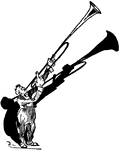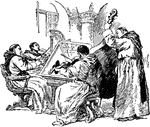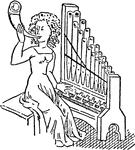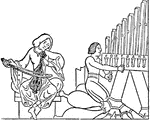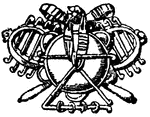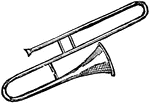
Lute
"The European lute is derived in form and name from the Arabic "el ud," "the wood," the consonant of…
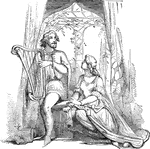
Man Playing a Harp for a Woman
A man and woman sitting together. The man is playing the harp and perhaps singing.
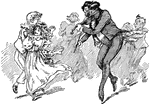
Man Playing Violin with Children Dancing
An illustration of a man playing the violin while children dance around.

Mandolin
A mandolin is a musical instrument in the lute family (plucked, or strummed). It is descended from the…
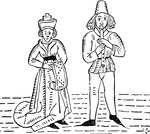
Music
The engraving, Music from 'Mirrour of the World' by William Caxton, the first English printer.
Musica
The word 'Musica' written in round writing. "A method of handwriting, characterized by strong curves…

Musical Instrument
A musical instrument is an object constructed or used for the purpose of making the sounds of music.…
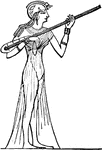
Egyptian musician
"That the Egyptians paid great attention to the study of music and had arrived at a very accurate knowledge…
Ophicleide
"The Ophicleide is a wind instrument of metal, invented to supersede the serpent in the orchestra and…
Plagiaulos
"The Plagiaulos. Castellani Collection (Maenad Pipes), British Museum." — The Encyclopedia Britannica,…
!["A pipe of this nature fitted with a piece of glass so as to exhibit the reed (which is a "free reed") is shown in [the illustration]. Q is the wind-chest of the bellows, into which P is fitted. In the right-hand figure the upper part of the pope is removed, so as to show the reed more clearly. A plate of metal c c, has a slit but in it, in which the tongue I may just past. By means of a curved wire, r, projecting above the top of the pipe, and the play of the tongue may be controlled and the pipe tuned. The conical pipe, H, placed at the top, serves to increase the power of the sound". -Benson, 1891](https://etc.usf.edu/clipart/62100/62146/62146_reed_mth.gif)
Reed
"A pipe of this nature fitted with a piece of glass so as to exhibit the reed (which is a "free reed")…
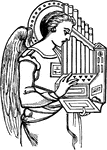
Regal
A small portable organ played with the figures of the right hand, the left being used in working the…
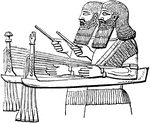
Assyrian Sacbut
A musical instrument of the trumpet kind with a slide; in fact an old variety of trombone. The instrument…

Sansa
"Sansa. An African musical instrument which consists of a sounding-board of some hard wood with strips…

Sarinda
"Sarinda. A Hindu viol, which has a body made of a single wooden block, elliptical in general contour,…

Saul Tries to Kill David with His Javelin
"And an evil spirit from Jehovah was upon Saul, as he sat in his house with his spear in his hand; and…

Saxhorn
The saxhorn is a brass instrument with: a, mouthpiece; b, valves; c, keys; d, bell; e, crook.

Saxophone
"The saxophone, a brass musical instrument invented by Adolphe Sax. It consists of a conical brass tube,…

Serpent
The serpent is "a musical instrument, properly of the trumpet family, having a cupped mouthpiece, a…
Shamisen
The shamisen or samisen is a Japanese stringed instrument played with a plectrum (a) called a bachi.

Sheng
One of the most important musical instruments in use among the Chinese, one that is indispensable to…
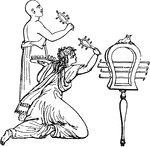
Sistrum
"The sistrum was an Egyptian instrument of music, used in certain ceremonies by that people, and especially…

Skylark
"The common lark of Europe, Alauda arvensis: so called because it mounts toward the sky and sings as…

Sonometer
A sonometer is an apparatus by which the transverse vibrations of strings can be studied. It is also…
Spinet
"The spinet is a keyed musical instrument much in use from 1500 to 1760. It derived its name from the…
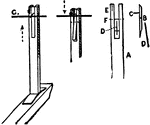
Interior mechanism of a spinet
"Interior mechanism of a spinet. A, Jack; B, tongue; C, quill; D, bristle; E, cloth damper; F, pivot;…
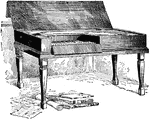
Mozart's Spinet
"The spinet had only one string to a note, plucked by means of a quill or a plectrum of leather."—Webster,…
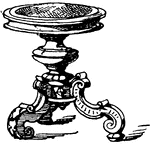
Modern Music Stool
The Music Stool is primarily used in an office or for music performers. The stool can spin around and…
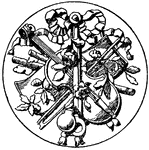
Big Medallion Symbol
The big medallion symbol is a symbol of a violin and castanet with the background of a sheet of music.…
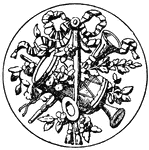
Medallion Symbol
The medallion symbol is a symbol of a tambourine with flutes in the background. Designed by sculptor…
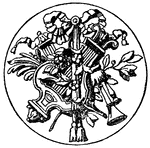
Medallion Base Symbol
The medallion base symbol is a symbol of a lyre. Designed by sculptor Lehr of Berlin, Germany which…

Ornament Medallion Symbol
This ornament medallion symbol is a symbol of musical instruments that represent the art of singing.…
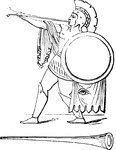
Roman trumpet
"There appears to have been no essential difference in form between Greek and Roman or Tyrrhenian trumpets.…

Tuning Fork
A tuning fork is an acoustic resonator in the form of a two-pronged fork with the tines formed from…
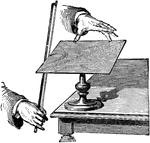
Vibration of Plates
An illustration showing the vibration of plates be using a rosined bow and a steel plate.


